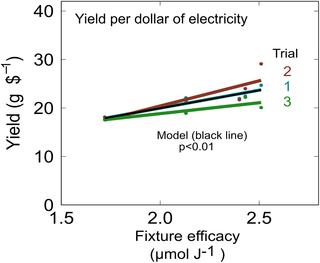grampanew2this
Member
I have a vipar spectre with red, blue and white individually controllable lighting.....The plant loves all of them on at full...but should I turn on only my red when its budding time?
Grow light vendors have been pushing UV-B for about 18 months now. The justification, that I've read, is that a research that said that the enhancement effect was equivocal because, in one test, CBD was increased while it was not increased in another. The grow light industry saw that one trial had an increase. Bugbee argues that "equivocal" means…equivocal.Possibly just bro-science that I never bothered to fully explore, but I was under the impression blue lighting in flower supposedly increased cannabinoids. Not sure how the total power in their light is divided up between white, red and blue, but presumably there would also be measurable yield penalty from losing a percentage of available wattage by switching off the blue.
does he ever mention the actual wavelengths in the "blue light"?Perhaps, due to the "blue photon penalty"
The range is 401-500nm is mentioned in the text but 400-500nm is in one of the graphics so I'll go with 400-500 (it's easier to type, too).does he ever mention the actual wavelengths in the "blue light"?
is this a trial on hemp???CBD and THC were 8% and 0.3% at harvest in trials
Yes. That's no secret. He's in the US and federally funded. It's cannabis cannabis that's been bred to have a low THC yield and it's used in research in the US because cannabis cannabis is a Schedule I drug.is this a trial on hemp???
thc at less than 1%?
I don't know which figure you're referring to. I've seen lots of graphics that show what McCree discovered 50+ years ago. They're variations on a theme because plants haven't fundamentally changed in the last 5 decades and, yes, blue photons result in a lot of photosynthesis.check out a chlorophyll absorption chart for cannabis and you'll see a huge blue spike.
I'm not arguing "no blue". If there's 0% blue, you'll get deformed growth (can't cite that - it's in a paper on my computer and I'm not interested in digging it up).i'm not a Doctor like Bugbee but i'm calling BS on no blue in bloom
For what it's worth, you will get better results with a modern white light.cool, thanks

 www.viparspectra.com
www.viparspectra.com
this graph here would tell me that there is a massive blue and orange-ish spike for chlorphyll absoption. wouldn't you agree??I don't know which figure you're referring to. I've seen lots of graphics that show what McCree discovered 50+ years ago. They're variations on a theme because plants haven't fundamentally changed in the last 5 decades and, yes, blue photons result in a lot of photosynthesis

i'm guessing this was your source?On the other hand, I've presented evidence that shows that there's a significant loss in yield when the % of blue photons exceeds 4% in flower. And I've only delved into a couple of sources
Completely. Just like McCree discovered.this graph here would tell me that there is a massive blue and orange-ish spike for chlorphyll absoption. wouldn't you agree??
View attachment 5321601


Yup.i'm guessing this was your source?

Cannabis lighting: Decreasing blue photon fraction increases yield but efficacy is more important for cost effective production of cannabinoids
LED technology facilitates a range of spectral quality, which can be used to optimize photosynthesis, plant shape and secondary metabolism. We conducted three studies to investigate the effect of blue photon fraction on yield and quality of medical hemp. Conditions were varied among studies to...journals.plos.org
i've been reading bits and pieces so far.
to be honest, most of that info is very interesting, but for a small grower, i'm not so much interested in less yield but better quality.In short, I think I understand where you're coming from
In response to the OP's question, it all depends on how big your light is compared to your grow area.I have a vipar spectre with red, blue and white individually controllable lighting.....The plant loves all of them on at full...but should I turn on only my red when its budding time?
From what I have read, it was strain dependent. Interestingly, this research appears to correspond with exactly what I was saying about concentrations of red light in chloroplasts."TOCC’s next study is focused on effects of different light spectra at various PPFDs. The best yields to date have been with Fluence’s broad-spectrum R4 lighting. Type 1 (high-THC, low-CBD) cannabis grown at 1,500 PPFD under R4 showed 17% higher yields in dry bud weight as compared to R6. Higher fractions of red light (corresponding with higher R numbers) tracked lower yields for the company. "
KEY FINDINGS
By cultivar, ICL spectrum only affected the Jack 22 strain grown under broad white + far red (R4FR). These plants showed higher dry weight yield when compared to plants grown under higher red light levels. Light spectrum had less of an impact on more stretched strains like Blue Dream, Blank Check, and Godfather, which all showed similar yield results.
